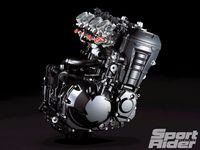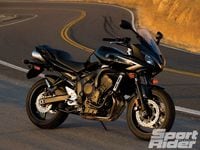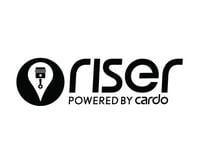New-Bike Break-In
I purchased a new Kawasaki Z1000 on Saturday and am in the process of breaking in the engine. My owner's manual says to keep rpm below 4000 for the first 500 miles, and below 6000 for the next 500 miles. I have two questions. First, I am curious to know why modern motorcycle engines require a break-in period, while modern car engines do not. Is there something different about the manufacturing processes or materials used in car engines? Or are car engines broken in at the factory? Second, I am curious whether Kawasaki's break-in guidelines are too conservative. Many sources on the internet recommend a much more aggressive break-in procedure; they claim that if a new engine is driven too timidly, the rings will not seat well and compression will be lower than optimal. What is your opinion on the optimal break-in procedure for a typical street rider?
Vic Anand
Lansing, NY
**I'm not sure where you got your information about break-in for cars; most new cars need at least some break-in time. The owner's manual for my Scion xB calls for a 1000-mile period to "drive gently and avoid high speeds," along with recommendations to avoid full-throttle acceleration, lugging the engine, or driving for a long time at a constant speed - all similar to how you'd want to break-in a motorcycle engine. The owner's manual for my wife's Honda Civic lists a similar procedure for the first 600 miles. Breaking in a new or rebuilt engine is always a compromise between two goals that are at odds with each other: On the one hand, you need to put enough of a load on the engine to properly seat the rings against the cylinder walls. On the other, you need to take it easy for a while so that things like the transmission gears and main bearings can properly mate.
You should follow the recommended rpm limits and mileage that your owner's manual lists, but don't be afraid to use occasional bursts of acceleration at a light load to those rpm limits or even higher. Once you're past the 1000-mile mark in your case, some runs to a gradually higher rpm limit - and eventually redline - will provide some load to help seat the rings. I agree that some manufacturers' break-in recommendations may be conservative, but there are other aspects to consider. It's not a good idea to be blasting down the road at full throttle and maximum rpm trying to break in your new bike that also has new tires and brakes. And if you have a warranty issue later on, you'll want to say you followed the manual for break-in. I can't say from personal experience if a quick or long break-in is best, but perhaps most telling is this: When we get new bikes to test, the manufacturers almost always take the time to log at least a few hundred miles on them beforehand.**
FZ6 slip-on and air filter remapping
I have a 2007 FZ6 and recently added Leo Vince Carbon slip-ons. I have not done any remapping (because Leo Vince claims none is needed with its slip-ons) and have done no other modifications. So, I was wondering if any remapping is needed with just the exhaust swap? How about if I also added a K&N; filter, would remapping be needed then?
Also, I went on a wonderful ride from San Diego on Hwy 94 East (nice winding road along the Mexican border) and before I left the house I removed the dB killers. I noticed that the bike was a little louder, especially at higher RPM's and the idle was a little rough. Power seemed to be improved at mid-range and high-end, but I'm not sure if that is actually the case. Can you explain how dB killers affect performance and what impact removing them has? Does removing them require any type of fuel remapping?
Adam Rock
San Diego, CA
**With the slip-ons alone, your bike is probably fine with no remapping of the fuel injection system, as Leo Vince claims. K&N; also claims its air filter "can be used in a stock machine, with no modifications required." Both accessories together, however, puts you in a grey area as far as remapping is concerned and it would be worth investing in an EFI tool and some dyno time to properly tune it. This would give you optimum ridability and horsepower in addition to peace of mind knowing that your bike wouldn't be running dangerously lean.
Most dB killers, like the Leo Vince pieces, add back-pressure to the exhaust to decrease noise. In our experience, performance is affected very little and we've even had some slip-ons show more horsepower with their sound-reducing inserts installed. Your bike may idle rougher without the inserts as the fueling requirements may be slightly different, but I would suspect that the additional noise simply makes your bike sound rougher. Likewise, it's doubtful your bike makes enough additional power without the dB killers that you would feel a difference - the extra noise makes you perceive it as such. Still, if you go the route of a remapping device you would certainly want to tune it as you plan on riding your bike - with or without the inserts.**
Got a question?
The Geek
831 S. Douglas St.,
El Segundo, CA 90245
or e-mail srmail@sorc.com












/cloudfront-us-east-1.images.arcpublishing.com/octane/AUE3NFVRRZDSBIDVUGIYIDQNUI.jpg)
/cloudfront-us-east-1.images.arcpublishing.com/octane/LYR62CH2WNBMHJJVXVATZHOUE4.jpg)
/cloudfront-us-east-1.images.arcpublishing.com/octane/RBCTRGBQYBDK7A6XPG3HKPS7ZQ.jpg)
/cloudfront-us-east-1.images.arcpublishing.com/octane/MQXQRYMZVBCWJIRYP3HEN3SHVE.jpg)
/cloudfront-us-east-1.images.arcpublishing.com/octane/TSPODNNEWRDSVJGUCNQTDG4ADI.jpg)
/cloudfront-us-east-1.images.arcpublishing.com/octane/X5TB7BDV4BA2RPSY54ZGK27RP4.jpg)
/cloudfront-us-east-1.images.arcpublishing.com/octane/REUHOJXRDBGZ5IHBYZCCBCISPA.jpg)
/cloudfront-us-east-1.images.arcpublishing.com/octane/52LGJTCKBFEHDF7S7H4CVUIMGM.jpg)
/cloudfront-us-east-1.images.arcpublishing.com/octane/YMWAIPIPSJAOXOU3QMJMGH37OM.jpg)


/cloudfront-us-east-1.images.arcpublishing.com/octane/EJ6KZRGAYBCVXNL2PJXL37UVWQ.jpg)
/cloudfront-us-east-1.images.arcpublishing.com/octane/AAN4TI76M5H5JMUVEIGASWXBDU.jpg)
/cloudfront-us-east-1.images.arcpublishing.com/octane/P3RXD2UCPFF37CMB7CHPVKXORY.jpg)
/cloudfront-us-east-1.images.arcpublishing.com/octane/VZEG2EJI2RDFZNHLRZMU56MD3Q.jpg)
/cloudfront-us-east-1.images.arcpublishing.com/octane/GVJQO5FFOFBWNGODOBRB4FBAW4.jpg)
/cloudfront-us-east-1.images.arcpublishing.com/octane/BIVAK2SFIBDJJM25E7I5VU2FJE.jpg)
/cloudfront-us-east-1.images.arcpublishing.com/octane/CH5VX52UG5CFHOVH5A6UYEFWWA.jpg)
/cloudfront-us-east-1.images.arcpublishing.com/octane/ZVGJNGZRU5C33N7KN23BBFKSC4.jpg)


/cloudfront-us-east-1.images.arcpublishing.com/octane/CZ5OM3E43ZEXJHY7LCYXCHLIKI.jpg)
/cloudfront-us-east-1.images.arcpublishing.com/octane/DF5T4K5KPZFJXFCTGPYR77PKJM.jpg)
/cloudfront-us-east-1.images.arcpublishing.com/octane/RMCT2KVQBJHBZMRTSLOVPMOILU.jpg)